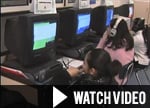 MONTGOMERY COUNTY PUBLIC SCHOOLS
MONTGOMERY COUNTY PUBLIC SCHOOLS
 MONTGOMERY COUNTY PUBLIC SCHOOLS
MONTGOMERY COUNTY PUBLIC SCHOOLS
Parents → Prekindergarten to High School → Middle School
 In middle school, your child will be in a larger building where he or she will learn new subjects, meet new classmates, have more freedom, and take on more responsibility. This is probably the first time students will be changing classes for all subject periods, not just for a few classes. The more your child knows about what to expect in middle school, the easier the transition will be.
In middle school, your child will be in a larger building where he or she will learn new subjects, meet new classmates, have more freedom, and take on more responsibility. This is probably the first time students will be changing classes for all subject periods, not just for a few classes. The more your child knows about what to expect in middle school, the easier the transition will be.
Students receive their class schedule during the summer. It is important for you and your child to review this schedule as soon as you receive it. If you want to make changes to the schedule, contact your child's counselor or team leader before the start of school.
All middle schools conduct 6th grade orientation. This orientation typically is scheduled on several dates in the summer and students may choose when they want to attend. During orientation, your child will have the opportunity to meet teachers and other school staff, take a tour of the school, and meet classmates.
An additional orientation is held for incoming sixth graders and other new secondary students on the Thursday before the start of school. This half-day orientation gives students a chance to take a test run on their bus route and become acquainted with their class schedule and teachers.
Get the Conversation Going
One of the best ways to make sure your child is successfully making the transition to middle school is to talk about what is happening in school. Try some of these "sentence starters" to get the conversation going.
 Students in each grade level are divided into teams. A team leader works closely with the teachers, counselor, and administrator who complete the team. The team structure makes it easier for students to connect with their classmates and develop a rapport with their teachers.
Students in each grade level are divided into teams. A team leader works closely with the teachers, counselor, and administrator who complete the team. The team structure makes it easier for students to connect with their classmates and develop a rapport with their teachers.
Most middle schools begin at 7:55 a.m. and dismiss at 2:40 p.m. Schools have two options for scheduling classes: the seven period day or block scheduling. In the seven period day format, students have the same class schedule for the week and classes are approximately 45 minutes long. If your school uses block scheduling, class periods could be up to 90 minutes long, and students have different classes on different days of the week. Your child's school will provide information about how classes are scheduled.
In middle school, your child will be assigned two lockers-a hall locker and a physical education (PE) locker. The hall locker is used to store backpacks, coats, books, and other supplies. Students must keep their backpacks in their lockers during the school day-backpacks are not permitted in classrooms. Students are required to change into appropriate athletic clothing for physical education classes; PE lockers hold your child's clothes and other possessions during PE class.
Some middle schools have advisory periods. These periods vary from school to school, so activities may differ. Depending on how your school structures this period, students may use this time to organize materials, work on activities that support student learning, talk about assignments, make up tests and quizzes, or get extra help with a subject.
Students can expect more homework in middle school than they were assigned in elementary school. In Grades 6-8, homework averages 60 minutes per night, four to five times per week. Teachers generally require students to write their homework assignments in their planners or assignment books.
All students need to participate in student service learning (SSL) activities to graduate from high school. Starting with the graduating Class of 2011, 75 SSL hours will be required. An SSL coordinator is assigned to each middle and high school to help students meet the requirement. Students may begin to earn SSL hours the summer after completing Grade 5.
Additional Information
 All middle schools offer courses in reading/English language arts, math, science, social studies, physical education, health education, art, and music. A variety of elective courses, which vary from school to school, also are available for students to pursue specific areas of interest. These courses may include band, orchestra, chorus, art, theater, and career and technology education.
All middle schools offer courses in reading/English language arts, math, science, social studies, physical education, health education, art, and music. A variety of elective courses, which vary from school to school, also are available for students to pursue specific areas of interest. These courses may include band, orchestra, chorus, art, theater, and career and technology education.
Middle school students can take some courses for high school credit. These courses include algebra, geometry, and foreign language classes. Note: students must take the final exam in order to receive credit on their official transcript. Students taking high school courses requiring a High School Assessment (HSA) must take the HSA upon completion of the course. Note that the grades for high school courses go on the studentÕs official transcript.
All 6th grade students spend three days and two nights at one of three outdoor education centers. Students are accompanied by teachers and volunteers. This program supports learning about different aspects of nature, including forest, field, stream, and pond. Students also learn about local history, wildlife, astronomy, and aspects unique to each site. A fee covers food, lodging, transportation, and insurance. Financial assistance is available to students if needed.
 All middle schools have an afterschool extracurricular activities program. Activities may include study/homework club, newspaper club, yearbook club, math team, Student Government Association (SGA), and performance groups.
All middle schools have an afterschool extracurricular activities program. Activities may include study/homework club, newspaper club, yearbook club, math team, Student Government Association (SGA), and performance groups.
All middle schools offer an intramural sports program for girls and boys in Grades 7 and 8. To participate in athletics, students are required to submit a medical evaluation form, a parent permission form, and a transportation permission form, if necessary. The medical evaluation form requires students to have a physical examination by a medical practitioner. If you need assistance arranging for your child to have a physical examination, contact the school's health technician.
Students who wish to participate in extracurricular activities or sports must maintain a 2.0 marking period average, with not more than one failing grade in the previous marking period. If these requirements are not met, the student is academically ineligible to participate in extracurricular activities, including sports.
Middle schools recognize students for outstanding achievement in a variety of ways, including honor roll and recognition assemblies. Student performances such as choral and band concerts and plays are also a part of the middle school experience, and attending these events is a great way for parents and families to stay connected with the school community.
Student photos are taken each year for the school yearbook. Some middle schools also use these photos to issue school ID cards.
 When your child is in 8th grade, you will begin to receive information about high school. There also will be meetings for you to attend to learn more about the transition from middle school and how to help to prepare your child for this new experience. Look for information from your child's middle school and visit your high school's website for announcements about upcoming events and opportunities for incoming students and their parents.
When your child is in 8th grade, you will begin to receive information about high school. There also will be meetings for you to attend to learn more about the transition from middle school and how to help to prepare your child for this new experience. Look for information from your child's middle school and visit your high school's website for announcements about upcoming events and opportunities for incoming students and their parents.
In January or February, parents of Grade 8 students are invited to attend a meeting at their student's high school. At this meeting, administrators and school counselors provide general information about the high school program, introduce key staff, and provide tours of the school.
Also in the winter of Grade 8, high school counselors visit middle schools to talk with 8th grade students about what to expect in high school. Students receive the High School Course Bulletin, which includes information on graduation requirements and the wide variety of courses offered in high school. The High School Course Bulletin is available online. Students become familiar with the worksheet used to develop their academic programs for the next four years and learn about the process that will guide them through this activity.
Additional Information